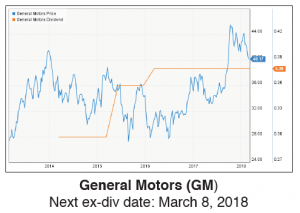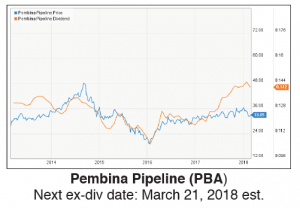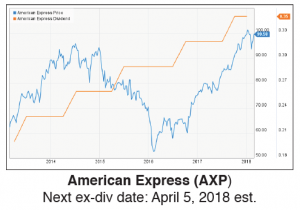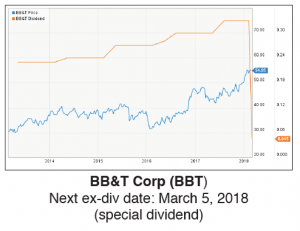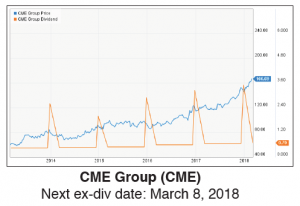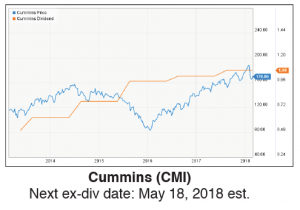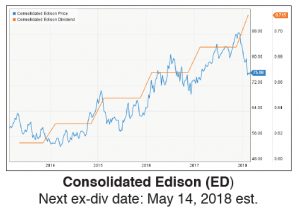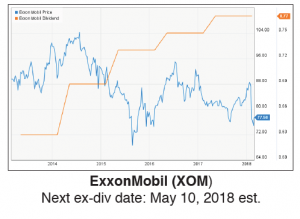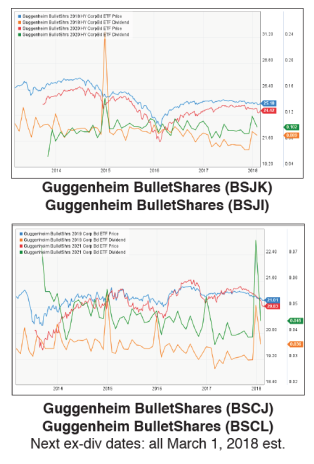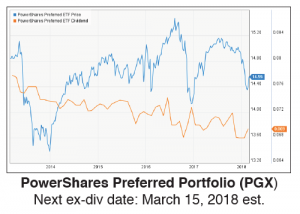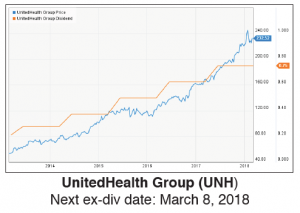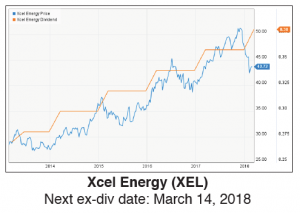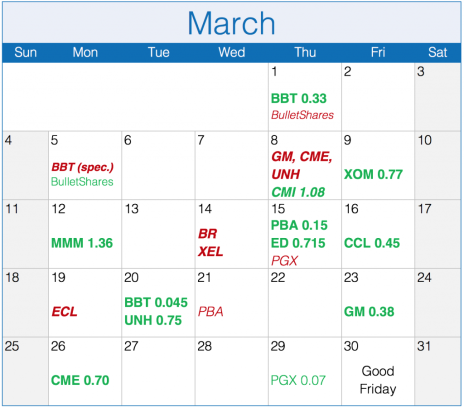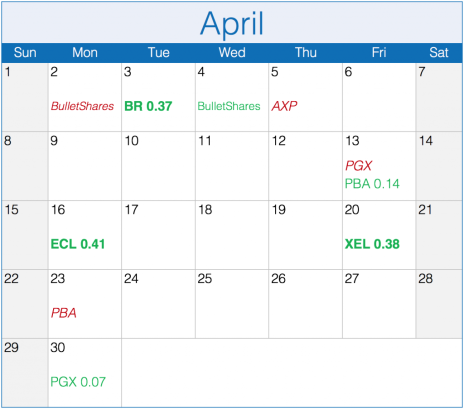We’re clearing one underperforming stock from the portfolio today, and putting one dividend stalwart back on Buy. In today’s issue, you’ll also find a very high-yielding new addition, a recap of our sell strategy and updates on all our stocks.
Cabot Dividend Investor 218
[premium_html_toc post_id="145659"]
Back in Black
After a panicky start to February, markets pulled themselves together over the past two weeks. Volatility declined and the major indexes all ended higher last week.
The all-clear hasn’t sounded yet, but our market-timing expert, Mike Cintolo, says that once all the major indexes move decisively back above their 50-day moving averages, it’s probably safe to get back in the water.
Fixed income remains a minefield, however. The market was shaken yesterday by comments from new Fed Chair Jerome Powell that suggested the Fed is considering hiking interest rates four times this year. He also said his “personal outlook for the economy has strengthened since December,” surprising analysts who thought the Fed might respond to the recent stock market turbulence by adopting a more dovish tone.
[highlight_box]What To Do Now: We have two housekeeping moves today: we’ve sold our remaining quarter-position in Wynn (WYNN) for a nice profit, and we’re getting rid of the rest of our losing position in Exxon Mobil (XOM). With those two stocks out of the way, our portfolio is tightened up and well-positioned for the market’s next move, so we’re getting a tad more bullish by putting 3M (MMM) back on Buy and adding a finance stock to the High Yield Tier. [/highlight_box]
Featured Buy
AllianceBernstein (AB)
This month, I’m adding a 8.4%-yielding asset manager to the High Yield Tier. The company is organized as a partnership, which may turn some investors off. But if you don’t mind a little extra paperwork, AllianceBernstein (AB) combines high yield, high growth expectations and a strong chart into one attractive package.
The Company
AllianceBernstein is a New York-based investment manager. Very roughly, about 60% of AB’s clients are institutions (like pension funds) and 40% are retail investors. About 57% of clients are based in the U.S. (or at least their assets are). The company’s strength is active management.
AllianceBernstein, or AB, was formed in 2000 when Alliance Capital, known for its growth-oriented mutual funds, acquired Sanford C. Bernstein, a money management firm known for its value-oriented research.
The combined AB invests across all markets and strategies, including equity, fixed income and alternative assets. In addition to managing client money, AB offers mutual funds, and provides research, brokerage and trading services to institutional clients. About 65% of AB is owned by the French insurance giant AXA.
While many investors are shifting to passive investing strategies—like index funds—AllianceBernstein is benefiting from a mini-renaissance in active strategies. In 2017, net flows into AB’s active strategies totaled $19 billion, with actively-managed fixed income funds getting the lion’s share. AB’s passively-managed assets declined by $6 billion.
Part of the reason is outperformance: 90% of AB’s assets under management outperformed their benchmark over the past five years, a track record that’s like catnip to investors large and small. AB’s fixed-income strategies did particularly well, accounting for the especially strong flows into the firm’s fixed income strategies in 2017. But AB’s equity investments also did well this year, particularly in the fourth quarter, when its five-year outperformance rate rose to 91%. That helped AB beat estimates by a large margin in its latest quarter, and is attracting even more investors.
Investors may also be turning to AB because they think active managers can help mitigate some of the risks facing fixed income investors today. For example, AB offers a mutual fund called the Bond Inflation Strategy Fund, which seeks to return more than inflation by using TIPS and derivatives. Another fund, the AB Limited Duration High Income Portfolio, claims it “manages interest rate risk by keeping an average duration of less than four years.”
Active management, of course, costs more than passive management, and the high demand for AB services allowed the company to raise its average fee rate by 2.7% last year.
The Dividend
Here’s where things get a little quirky. AllianceBernstein has paid distributions every quarter since 1988, but the amount is variable, based on available cash flow. So the company doesn’t score particularly well on our IRIS ratings, which reward consistency and predictability. AB’s Dividend Safety Rating is a 6.4 out of 10, reflecting the fact that quarterly distributions are unpredictable, even though the company’s annual payout hasn’t decreased since 2011. AB earns a fairly low Dividend Growth Rating of 3.5 out of 10, reflecting only two consecutive years of increases in the annual payout and a relatively low annual growth rate of 5%.
In addition, because AB is organized as a partnership, the distributions are considered return of capital, and the company issues a K-1 form instead of a 1099. That can be a turnoff for some investors, but if you’re willing to deal with a little extra paperwork, the company provides investors with ample tax guidance through its website. Do keep in mind though, that if you invest through a tax-advantaged fund like an IRA, you may incur additional taxes on your AB distributions. Click here to see Everything You Should Know about MLPs Before You Invest, also available on your subscriber website, for more details on the tax consequences of owning partnerships.
The Stock
So with all those caveats surrounding the distribution, what makes AB worth owning?
First, there’s the 8.5% yield (based on AB’s total distribution of $2.30 over the past 12 months.)
Then there’s the various catalysts for the stock to outperform over the next few years. As noted above, AB’s asset managers are delivering superior returns, attracting more investor dollars. The latest earnings beat prompted a handful of analyst upgrades, and analysts now expect AB to deliver 12% EPS growth this year and 4% growth in 2019. Over the next five years, EPS growth is expected to average 12%.
Lastly, there’s the chart. Way back in 2007, AB hit an all-time high north of 90. But the stock fell over 80% during the financial crisis, and has been trading under 35 ever since.
The stock’s latest peak was in mid-2015, but a series of earnings misses triggered a 45% correction over the next nine months. The stock quickly bounced back into the low 20s in early 2016, and has been trading in a range between about 20 and 26 ever since.
That’s formed a long base that will provide solid support when AB eventually starts a new uptrend. The stock made its first breakout attempt in the first week of this year, surging through resistance at 26 with impressive speed. February’s correction dragged AB back into its trading range, but the stock bounced off its 200-day moving average and rebounded enthusiastically, notching eight consecutive up days in a row. That brought AB back to its 52-week high from January, where the stock is hanging out now. A few weeks of decent support from the market looks like all AB needs now to really get going.
| AllianceBernstein (AB) | ||
|---|---|---|
| Price: 26 52-week range: 20.40-28.15 Market cap: $2.55 billion P/E: 12 | Current yield: 8.4% Annual dividend: $2.30 (variable) Most recent dividend: $0.84 Dividend Safety rating: 6.4 Dividend Growth rating: 3.5 | |
| Dividends since: 1988 Consecutive years of increases: 2 Qualified dividends? No | Payment Schedule: Quarterly Next ex-dividend date: May 3, 2018 est. | |
Portfolio at a Glance
Closing Prices on February 27, 2018
Portfolio Updates
High Yield Tier
The investments in our High Yield tier have been chosen for their high current payouts. These ?investments will often be riskier or have less capital appreciation potential than those in our other ?two tiers, but they’re appropriate for investors who want to generate maximum income from their? portfolios right now.
BUY – General Motors (GM 40 – yield 3.8%) – GM continues to trade between 40 and 42. It hasn’t made up its early February losses yet, but it remains above its 200-day moving average and I’m going to keep it cautiously on Buy. Increasing sales of traditional cars remains a challenge, and GM’s EPS are expected to decline slightly this year and next (although the company beat estimates by a large margin last year by focusing on profitability). Big picture, investors excited about autonomous vehicles are increasingly turning to GM. The company could launch an autonomous ridesharing fleet as soon as 2019. And last week, California approved testing autonomous vehicles without drivers in them, a first.
HOLD – ONEOK (OKE 57 – yield 5.2%) – ONEOK, a natural gas pipeline and processing company, reported fourth-quarter and full-year earnings yesterday. EPS met expectations and were up 21% year-over-year. Thanks to a nice uptick in volumes (at both the gathering and processing steps), revenue rose 43% to hit $3.8 billion, beating estimates. Management confirmed its dividend growth target of 9% to 11% per year. It also announced a significant increase in 2018 capital spending plans, which worried some analysts and caused the stock to pull back. However, the capital spending will finance projects that are expected to be more profitable than existing assets and that are backed by partner commitments or long-term contracts. OKE remains above its 50-day moving average, about halfway between its February correction low and its previous high, and within its long-term trading range dating back to the start of last year. A breakout past 60 would be bullish. Hold.
HOLD – Pembina Pipeline (PBA 33 – yield 5.1%) – PBA bounced nicely after reporting earnings on Friday, although it remains below its 50- and 200-day moving averages. Adjusted cash flow (which excludes high non-cash depreciation charges) rose 34% in the fourth quarter and 29% for the full year. Higher volumes drove faster-than-expected revenue growth of 37% in the fourth quarter. PBA is looking healthier, but remains a Hold for now.
Dividend Growth Tier
To be chosen for the Dividend Growth tier, investments must have a strong history of dividend increases and indicate both good potential for and high prioritization of continued dividend growth.
HOLD – American Express (AXP 100 – yield 1.4%) – AXP surged through its 50-day last week, bringing the stock back to its mid-January high. Buying power is strong, and I could put AXP back on Buy on a breakout to new highs. In the meantime, the company is defending itself at the Supreme Court in a lawsuit alleging anti-competitive practices. The plaintiffs argue that Amex’s merchant contracts are anti-competitive because they prevent merchants from steering customers toward other payment options, for example, by offering a lower price for those who pay by MasterCard or cash. MasterCard and Visa have faced similar lawsuits in the past and settled them by changing their contract terms.
BUY – BB&T Corp (BBT 55 – yield 2.4%) – BB&T announced a 4.5-cent special dividend on Thursday, to be paid in addition to its regular 33-cent dividend this quarter. The special dividend will be paid on March 20, to investors who own the stock on March 2. (The ex-dividend date for the regular dividend has already passed; it was February 9.) Management hopes to make the 4.5-cent boost a permanent addition to the quarterly dividend starting next quarter, but will have to secure approval from regulators when they submit their capital plans in the second quarter. If the $0.375 level is made permanent, the 13.6% boost will be a generous increase compared to BBT’s average annual dividend increase of 8%. (Note that the special dividend is reflected as a large drop in the orange line in the chart, because it’s lower than and paid separately from the regular dividend.) BBT remains a Buy; the stock is trading near its pre-correction high, and looks ready to break out to new highs any day.
BUY – Broadridge Financial Solutions (BR 101 – yield 1.4%) – Broadridge continues to hit new all-time highs. All is well at the company, which provides shareholder services and other services and technology to financial companies. Analysts expect EPS to rise almost 30% this year. Try to buy on a pullback.
BUY – Carnival (CCL 67 – yield 2.7%) – CCL closed below its 50-day moving average again this week, and the stock’s next uptrend may take a little longer to get started than we hoped. But I still think the stock’s next move is up. CCL spent the last five months consolidating, and had finally broken out to a new high just before the market correction started. Plus, analysts expect EPS to increase 13% this year and 15% next year.
BUY – CME Group (CME 167 – yield 1.7%) – CME continues to hit new all-time highs. Increased market volatility is expected to provide a nice boost to the company’s 2018 results. (CME operates exchanges where futures, options and other derivatives are traded.) Analysts are raising their 2018 estimates and upgrading the stock, which should fuel further gains. Buy on pullbacks.
HOLD – Cummins (CMI 170 – yield 2.5%) – CMI’s rebound continues. The stock is above its 200-day moving average, though still 11% below its late-January high. But the long-term trend is up, and global economic growth is driving demand for Cummins’ engines. Analysts expect Cummins to deliver 8% sales growth and 18% EPS growth in 2018.
SOLD – Wynn Resorts (WYNN 169 – yield 1.2%) – We sold the rest of our WYNN shares last Wednesday, for a profit of 80%. Our total return on the position (including dividends and our two previous sales) was 61%. If you want to hang on to WYNN (with an appropriate stop loss in place, of course) feel free, but we’ll move on to other opportunities. The stock’s relative underperformance in recent weeks suggests that buyers won’t be able to retake control for some time, and a lot of uncertainty now surrounds the company (namely, investigations by gaming boards in Nevada, Massachusetts and Macau, and the impact of Steve Wynn’s resignation.)
Safe Income Tier
The Safe Income tier of our portfolio holds long-term positions in high-quality stocks and other investments that generate steady income with minimal volatility and low risk. These positions are appropriate for all investors, but are meant to be held for the long term, primarily for income—don’t buy these thinking you’ll double your money in a year.
BUY – 3M (MMM 241 – yield 2.3%) – MMM pushed through its 50-day moving average in a nice show of strength last week. The company still has some ground to make up before it retakes its late-January high, but being above both moving averages gives us more confidence that the stock’s next move is up. I’m going to move MMM back to Buy for safe income investors today. The company offers unparalleled free cash flow generation and a very reliable 2.3% yield—3M has paid dividends consistently for 100 years, with increases every year since 1959. For investors worried about 3M’s high price, remember: it’s not how many shares you own, it’s the dollar value. (You can also consider using dividend reinvestment, which often allows you to buy fractional shares, to gradually increase your position size over time.)
HOLD – Consolidated Edison (ED 76 – yield 3.8%) – Utilities traded sideways this week, despite an uptick in the number of interest rate hikes expected this year. The sector is likely to stay out of favor for some time, but we’re betting most of the pain came early in the rate hike cycle, as in recent years. Now that investors have adjusted their expectations, the rate hikes themselves are likely to be absorbed more easily. ED is a Hold for long-term investors looking for slowly rising income.
HOLD – Ecolab (ECL 131 – yield 1.3%) – ECL remains below its 200-day moving average, although it is trending up. Analysts have been revising their 2018 and 2019 estimates higher since the company’s earnings report last Tuesday; EPS are now expected to rise 14% this year and 11% next year. That’s solid growth for a 95-year-old industrial company with a 31-year history of dividend growth. It’s not the strongest stock in our portfolio, but safe income investors can hold.
SELL – ExxonMobil (XOM 78 – yield 4.0%) – We still have half a position in XOM, and our loss has shrunk to 10%. The stock has climbed 4% in the past two weeks, thanks to an unexpected rebound in oil prices. In addition, even though XOM’s latest earnings report disappointed—with production declines shaking analysts—2018 estimates have moved up nicely in recent weeks. Analysts now expect XOM to report 33% EPS growth this year, up from the 23% consensus a few weeks ago. However, the damage done to the stock in February means XOM’s recovery is going to be a slog. The five-month uptrend that contributed to our decision to buy the stock is broken; the stock’s current trend is sideways at best. We’re going to sell the rest of our XOM shares today.
HOLD – Guggenheim BulletShares 2018 High Yield Corporate Bond ETF (BSJI 25 – yield 4.0%)
BUY – Guggenheim BulletShares 2019 Corporate Bond ETF (BSCJ 21 – yield 1.8%)
BUY – Guggenheim BulletShares 2020 High Yield Corporate Bond ETF (BSJK 24 – yield 4.9%)
BUY – Guggenheim BulletShares 2021 Corporate Bond ETF (BSCL 21 – yield 2.4%)
I recently switched the 2018 BulletShares fund to Hold; it matures at the end of this year and its yield will gradually decline over the next 10 months as Guggenheim moves the fund into cash. If you’d like to construct your own bond ladder today, start with BSCJ or its 2019 high yield counterpart, BSJJ. As a reminder, a bond ladder is a conservative strategy for generating income by buying a series of individual bonds or defined-maturity bond funds that mature in successive years. Because the BulletShares funds mature at the end of the year in their name (at which point Guggenheim disburses the net asset value of the ETF back to investors) they are a good store of value even when interest rates rise. The longer-dated funds may pull back temporarily when rates rise, as we’ve seen with the 2021 fund over the past few months, but as long as you hold until maturity, you can ignore the pullbacks. And if you reinvest the proceeds of the maturing fund in a new, longer-dated holding every year, you can secure a rising income stream as rates rise. Guggenheim is in the process of selling the BulletShares, and all its other ETFs, to Invesco, but I don’t expect the change in ownership to change anything for BulletShares shareholders.
BUY – PowerShares Preferred Portfolio (PGX 15 – yield 5.7%) – PGX is an ETF that holds preferred shares and pays dividends monthly, making it a good conservative holding for investors looking for regular income. The fund has low volatility but no capital appreciation potential; it generally trades between 14 and 16. The recent interest rate spike brought PGX down to about 14.5, where it’s buyable.
BUY – UnitedHealth Group (UNH 233 – yield 1.3%) – UnitedHealth is a major health insurer and provider of medical services. The company has an eight-year history of dividend growth and a payout ratio of only 27%. UNH is back above its 50-day moving average and has made up over half of its losses from the February correction. The stock’s long-term uptrend is intact, and analyst estimates are moving up. In 2018, UNH is expected to grow sales by 12% and EPS by 24%. Safe income investors can buy UNH here.
HOLD – Xcel Energy (XEL 44 – yield 3.3%) – XEL traded sideways this week and long-term investors whose primary goal is income can continue to hold. The utility just increased its dividend by 5.6%, the 14th consecutive annual increase in a row. XEL is a Minnesota-based utility, the largest producer of wind energy in the U.S., and has a highly reliable regulated income stream.
Closing Prices on February 27, 2018
Dividend Calendar
Ex-Dividend Dates are in RED and italics. Dividend Payments Dates are in GREEN. Confirmed dates are in bold, all other dates are estimated. See the Guide to Cabot Dividend Investor for an explanation of how dates estimated.
Our Sell Strategy
Anytime we do a bit of spring cleaning in the portfolio—like the round prompted by February’s correction—I like to review our rules for selling.
We try to invest for the long-term in the Cabot Dividend Investor, but that doesn’t mean just buying, holding and hoping.
In short, there are three things that can get a stock kicked out of the Dividend Investor portfolio:
1. The Stock’s Trend
2. Losses
3. Fundamentals
Any one of these can be enough reason to sell, but in practice, most of our sales involve some combination of these failures. Here’s a more in-depth look at each of the reasons for selling a stock, followed by a look at some recent sales.
Reason #1: The Stock’s Trend
We have a saying at Cabot: “the trend is your friend.”
But the converse is also true: when trends aren’t in your favor, they can be your worst enemy. Now, we’re not trend followers to the extent of our colleagues over at Cabot Top Ten Trader or Cabot Growth Investor, but we still realize the folly of fighting against a major trend.
So, when a stock is trending down and shows no sign of stopping—when it’s slicing through moving averages and support levels—it’s time to respect the trend and get out.
Reason #2: Losses
While we aim to invest long-term and will ride out some corrections, losing a chunk of your capital up-front is harder to recover from than you think, and not always worth tolerating for the promise of long-term returns. Once your initial investment is depleted, your remaining capital has to work even harder to make up the difference.
For example, if you buy a stock and it then falls 40%, it has to go up 67% just for you to get back your original investment.
To avoid getting into such a situation, simply keep your losses from getting too big. We use a 15% to 20% loss limit on most positions.
Reason #3: Fundamentals
A change in fundamentals is usually a supporting criteria rather than a primary reason for selling, because most fundamental changes will be reflected in the stock price (reason #1). But it can still be an important factor in our decision to sell. Cabot Dividend Investor investments are chosen after careful consideration of a number of important metrics that affect the company’s ability to pay its dividend, longevity and growth potential. If a company’s fundamentals start to slip in any area, the stock is at risk of no longer earning its place in our portfolio. That could include declining IRIS ratings, a rising payout ratio, or red flags in revenue, EPS or free cash flow trends.
Recent Sales
We’ve sold two stocks over the past two months, based on changes in their technical strength, fundamentals, and our returns. Here’s a closer look at each of those sales.
Welltower (HCN)
We sold half our Welltower shares at the end of December, after the stock dropped definitively through support at 65 (reason #1), bringing our loss to 15% (reason #2). Plus, 2018 earnings growth expectations were declining as inflation expectations rose (reason #3).
We sold the rest of our shares in the first week of February, as interest rates anxiety reached a fever pitch, the stock continued to fall and our losses continued to mount. The stock has fallen about 8% further since our final sale. Even if this is the bottom, the damage done means HCN won’t be a leader of the next market advance.
Wynn Resorts (WYNN)
Non-financial factors can also contribute to our decision making. After The Wall Street Journal published claims in late January that Steve Wynn serially sexually harassed his employees, the stock immediately fell 20%. We sold half our shares at that time, mostly because of the uncertainty created by the allegations and the related investigations, and the likelihood of subsequent analyst downgrades (reason #3). We sold the rest of our shares last week, after the stock failed to bounce during the market rally, demonstrating a lack of buying power (reason #1).
[premium_html_footer]
Your next issue will be published March 28, 2018
Cabot Wealth Network • 176 North Street • Salem MA 01970 • 978-745-5532
Neither Cabot Wealth Network nor our employees are compensated by the companies whose stocks we recommend. Sources of information are believed to be reliable, but are in no way guaranteed to be complete or without error. Recommendations, opinions or suggestions are given with the understanding that subscribers acting on the information assume all risks. © Cabot Wealth Network. Copying and/or electronic transmission of this report is a violation of U.S. copyright law. For the protection of our subscribers, if copyright laws are violated, the subscription will be terminated. To subscribe or for information on our privacy policy, call 978-745-5532, visit www.cabotwealth.com or write to support@cabotwealth.com.
[/premium_html_footer]





